Sainsbury's HRM: Talent Management, Employee Relations, and Practices
VerifiedAdded on 2023/01/13
|16
|4611
|90
Report
AI Summary
This report provides a detailed analysis of Human Resource Management (HRM) practices at Sainsbury's, a major UK retailer. It examines the purpose and functions of HRM, focusing on talent acquisition, employee relations, and the strengths and weaknesses of different recruitment and selection approaches. The report assesses how HRM functions contribute to providing necessary talent and skills to meet business objectives. It evaluates the effectiveness of various HRM practices, such as reward management and flexible working, in raising profit and productivity. Furthermore, the report explores the importance of employee relations in influencing HRM decision-making and identifies key elements of employment legislation and their impact. It includes a job description and person specification, providing a rationale for their use in the recruitment process. This comprehensive analysis offers insights into effective HRM strategies within a retail context, and similar solved assignments are available on Desklib for students.
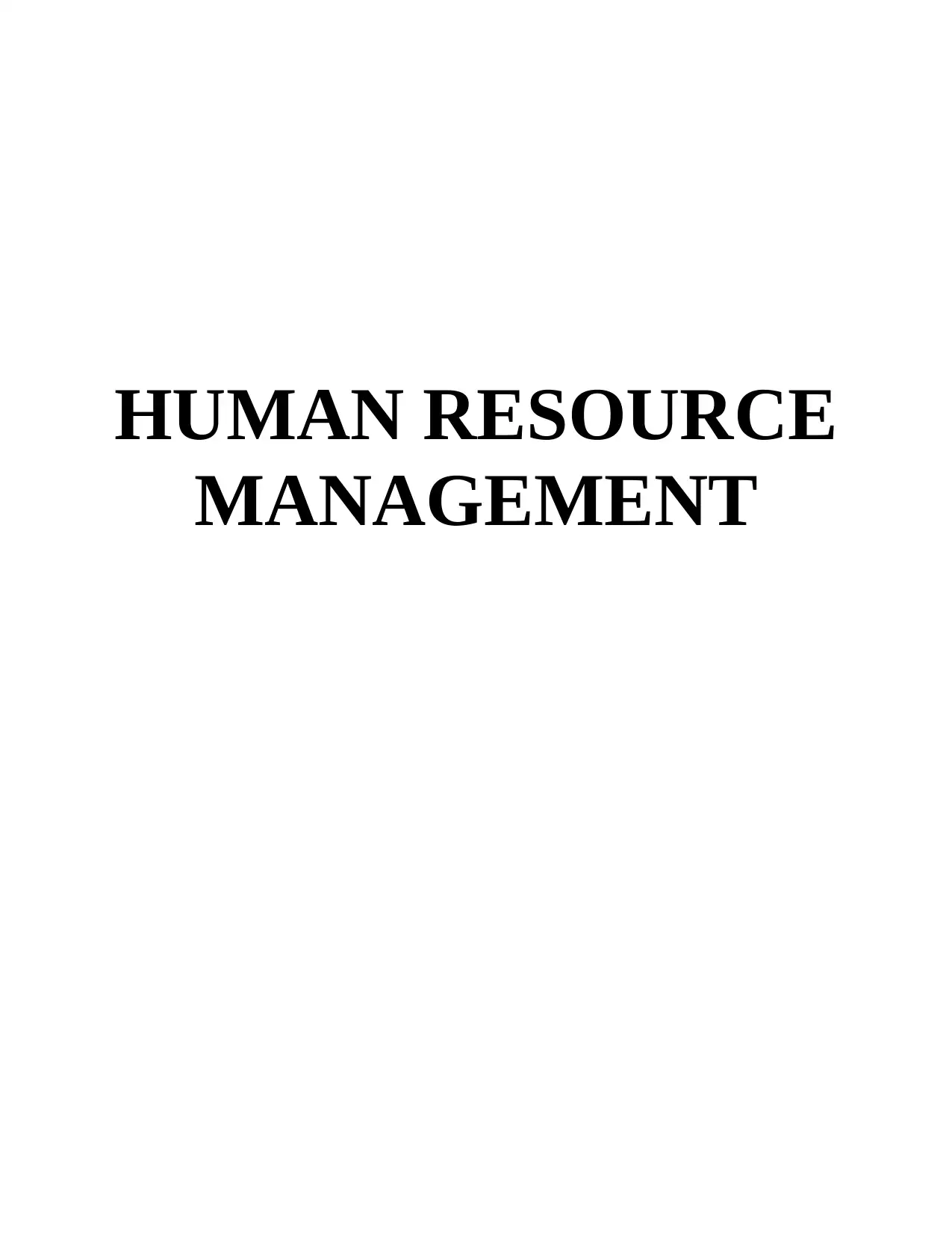
HUMAN RESOURCE
MANAGEMENT
MANAGEMENT
Paraphrase This Document
Need a fresh take? Get an instant paraphrase of this document with our AI Paraphraser
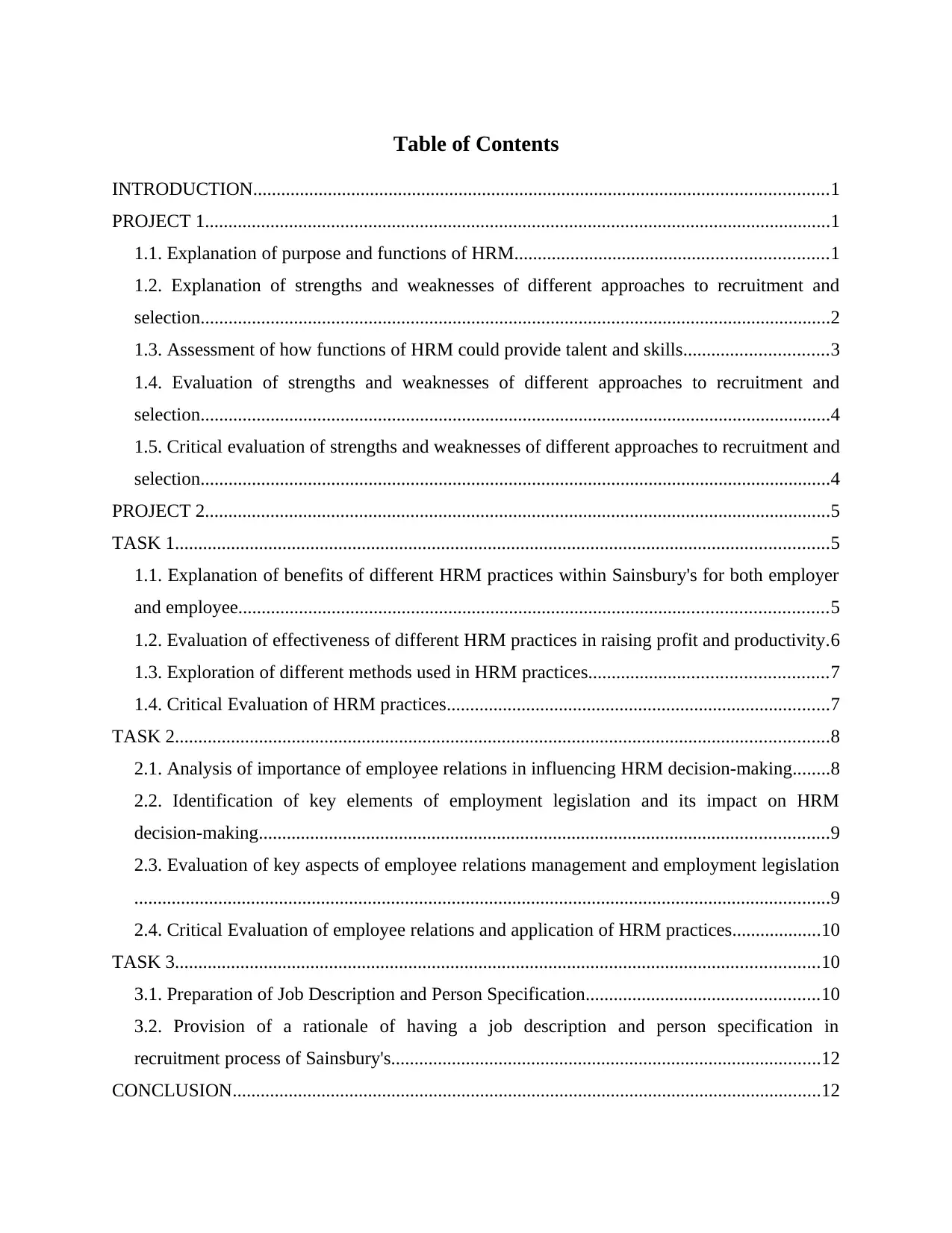
Table of Contents
INTRODUCTION...........................................................................................................................1
PROJECT 1......................................................................................................................................1
1.1. Explanation of purpose and functions of HRM...................................................................1
1.2. Explanation of strengths and weaknesses of different approaches to recruitment and
selection.......................................................................................................................................2
1.3. Assessment of how functions of HRM could provide talent and skills...............................3
1.4. Evaluation of strengths and weaknesses of different approaches to recruitment and
selection.......................................................................................................................................4
1.5. Critical evaluation of strengths and weaknesses of different approaches to recruitment and
selection.......................................................................................................................................4
PROJECT 2......................................................................................................................................5
TASK 1............................................................................................................................................5
1.1. Explanation of benefits of different HRM practices within Sainsbury's for both employer
and employee..............................................................................................................................5
1.2. Evaluation of effectiveness of different HRM practices in raising profit and productivity.6
1.3. Exploration of different methods used in HRM practices...................................................7
1.4. Critical Evaluation of HRM practices..................................................................................7
TASK 2............................................................................................................................................8
2.1. Analysis of importance of employee relations in influencing HRM decision-making........8
2.2. Identification of key elements of employment legislation and its impact on HRM
decision-making..........................................................................................................................9
2.3. Evaluation of key aspects of employee relations management and employment legislation
.....................................................................................................................................................9
2.4. Critical Evaluation of employee relations and application of HRM practices...................10
TASK 3..........................................................................................................................................10
3.1. Preparation of Job Description and Person Specification..................................................10
3.2. Provision of a rationale of having a job description and person specification in
recruitment process of Sainsbury's............................................................................................12
CONCLUSION..............................................................................................................................12
INTRODUCTION...........................................................................................................................1
PROJECT 1......................................................................................................................................1
1.1. Explanation of purpose and functions of HRM...................................................................1
1.2. Explanation of strengths and weaknesses of different approaches to recruitment and
selection.......................................................................................................................................2
1.3. Assessment of how functions of HRM could provide talent and skills...............................3
1.4. Evaluation of strengths and weaknesses of different approaches to recruitment and
selection.......................................................................................................................................4
1.5. Critical evaluation of strengths and weaknesses of different approaches to recruitment and
selection.......................................................................................................................................4
PROJECT 2......................................................................................................................................5
TASK 1............................................................................................................................................5
1.1. Explanation of benefits of different HRM practices within Sainsbury's for both employer
and employee..............................................................................................................................5
1.2. Evaluation of effectiveness of different HRM practices in raising profit and productivity.6
1.3. Exploration of different methods used in HRM practices...................................................7
1.4. Critical Evaluation of HRM practices..................................................................................7
TASK 2............................................................................................................................................8
2.1. Analysis of importance of employee relations in influencing HRM decision-making........8
2.2. Identification of key elements of employment legislation and its impact on HRM
decision-making..........................................................................................................................9
2.3. Evaluation of key aspects of employee relations management and employment legislation
.....................................................................................................................................................9
2.4. Critical Evaluation of employee relations and application of HRM practices...................10
TASK 3..........................................................................................................................................10
3.1. Preparation of Job Description and Person Specification..................................................10
3.2. Provision of a rationale of having a job description and person specification in
recruitment process of Sainsbury's............................................................................................12
CONCLUSION..............................................................................................................................12

REFERENCES..............................................................................................................................13
⊘ This is a preview!⊘
Do you want full access?
Subscribe today to unlock all pages.

Trusted by 1+ million students worldwide
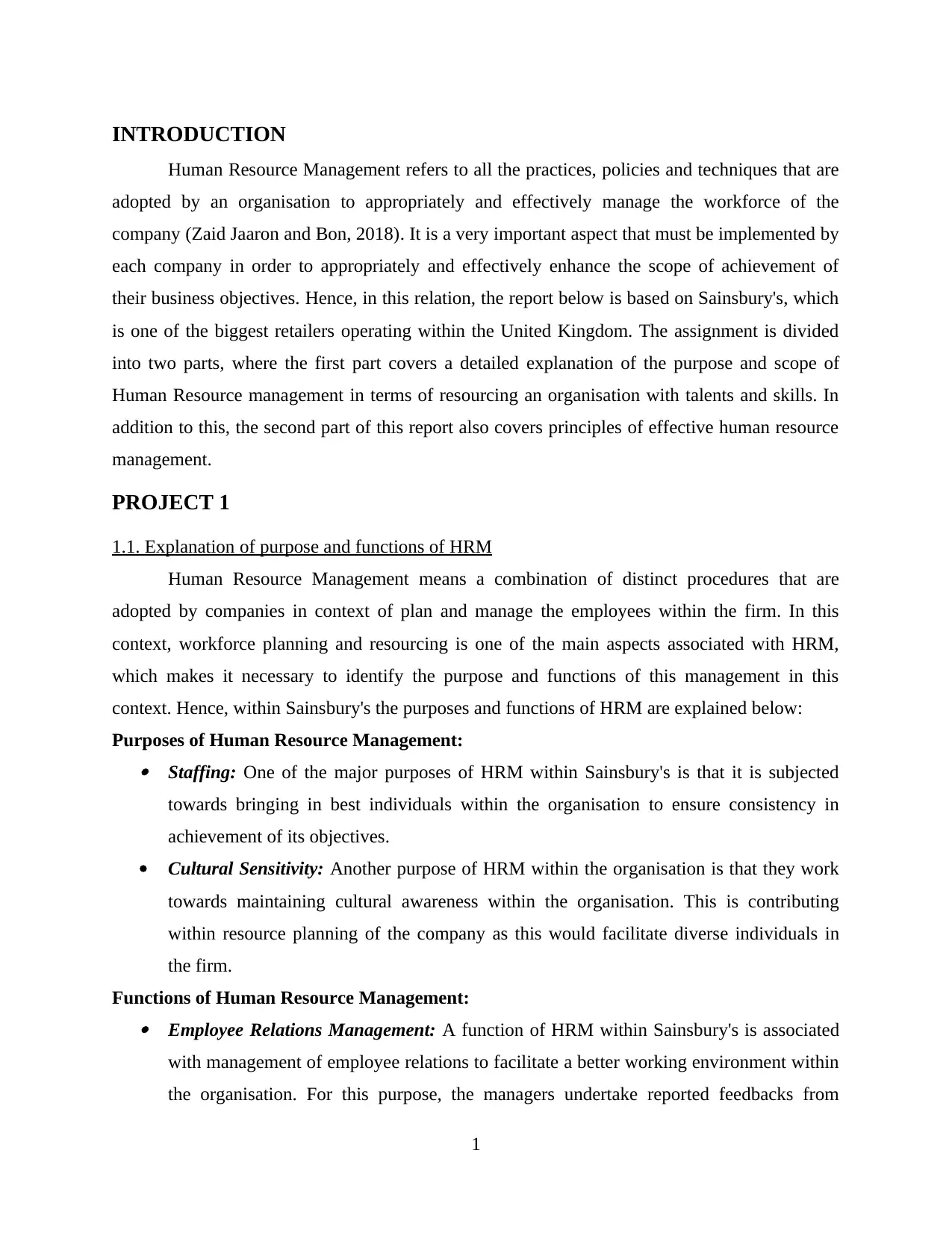
INTRODUCTION
Human Resource Management refers to all the practices, policies and techniques that are
adopted by an organisation to appropriately and effectively manage the workforce of the
company (Zaid Jaaron and Bon, 2018). It is a very important aspect that must be implemented by
each company in order to appropriately and effectively enhance the scope of achievement of
their business objectives. Hence, in this relation, the report below is based on Sainsbury's, which
is one of the biggest retailers operating within the United Kingdom. The assignment is divided
into two parts, where the first part covers a detailed explanation of the purpose and scope of
Human Resource management in terms of resourcing an organisation with talents and skills. In
addition to this, the second part of this report also covers principles of effective human resource
management.
PROJECT 1
1.1. Explanation of purpose and functions of HRM
Human Resource Management means a combination of distinct procedures that are
adopted by companies in context of plan and manage the employees within the firm. In this
context, workforce planning and resourcing is one of the main aspects associated with HRM,
which makes it necessary to identify the purpose and functions of this management in this
context. Hence, within Sainsbury's the purposes and functions of HRM are explained below:
Purposes of Human Resource Management: Staffing: One of the major purposes of HRM within Sainsbury's is that it is subjected
towards bringing in best individuals within the organisation to ensure consistency in
achievement of its objectives.
Cultural Sensitivity: Another purpose of HRM within the organisation is that they work
towards maintaining cultural awareness within the organisation. This is contributing
within resource planning of the company as this would facilitate diverse individuals in
the firm.
Functions of Human Resource Management: Employee Relations Management: A function of HRM within Sainsbury's is associated
with management of employee relations to facilitate a better working environment within
the organisation. For this purpose, the managers undertake reported feedbacks from
1
Human Resource Management refers to all the practices, policies and techniques that are
adopted by an organisation to appropriately and effectively manage the workforce of the
company (Zaid Jaaron and Bon, 2018). It is a very important aspect that must be implemented by
each company in order to appropriately and effectively enhance the scope of achievement of
their business objectives. Hence, in this relation, the report below is based on Sainsbury's, which
is one of the biggest retailers operating within the United Kingdom. The assignment is divided
into two parts, where the first part covers a detailed explanation of the purpose and scope of
Human Resource management in terms of resourcing an organisation with talents and skills. In
addition to this, the second part of this report also covers principles of effective human resource
management.
PROJECT 1
1.1. Explanation of purpose and functions of HRM
Human Resource Management means a combination of distinct procedures that are
adopted by companies in context of plan and manage the employees within the firm. In this
context, workforce planning and resourcing is one of the main aspects associated with HRM,
which makes it necessary to identify the purpose and functions of this management in this
context. Hence, within Sainsbury's the purposes and functions of HRM are explained below:
Purposes of Human Resource Management: Staffing: One of the major purposes of HRM within Sainsbury's is that it is subjected
towards bringing in best individuals within the organisation to ensure consistency in
achievement of its objectives.
Cultural Sensitivity: Another purpose of HRM within the organisation is that they work
towards maintaining cultural awareness within the organisation. This is contributing
within resource planning of the company as this would facilitate diverse individuals in
the firm.
Functions of Human Resource Management: Employee Relations Management: A function of HRM within Sainsbury's is associated
with management of employee relations to facilitate a better working environment within
the organisation. For this purpose, the managers undertake reported feedbacks from
1
Paraphrase This Document
Need a fresh take? Get an instant paraphrase of this document with our AI Paraphraser
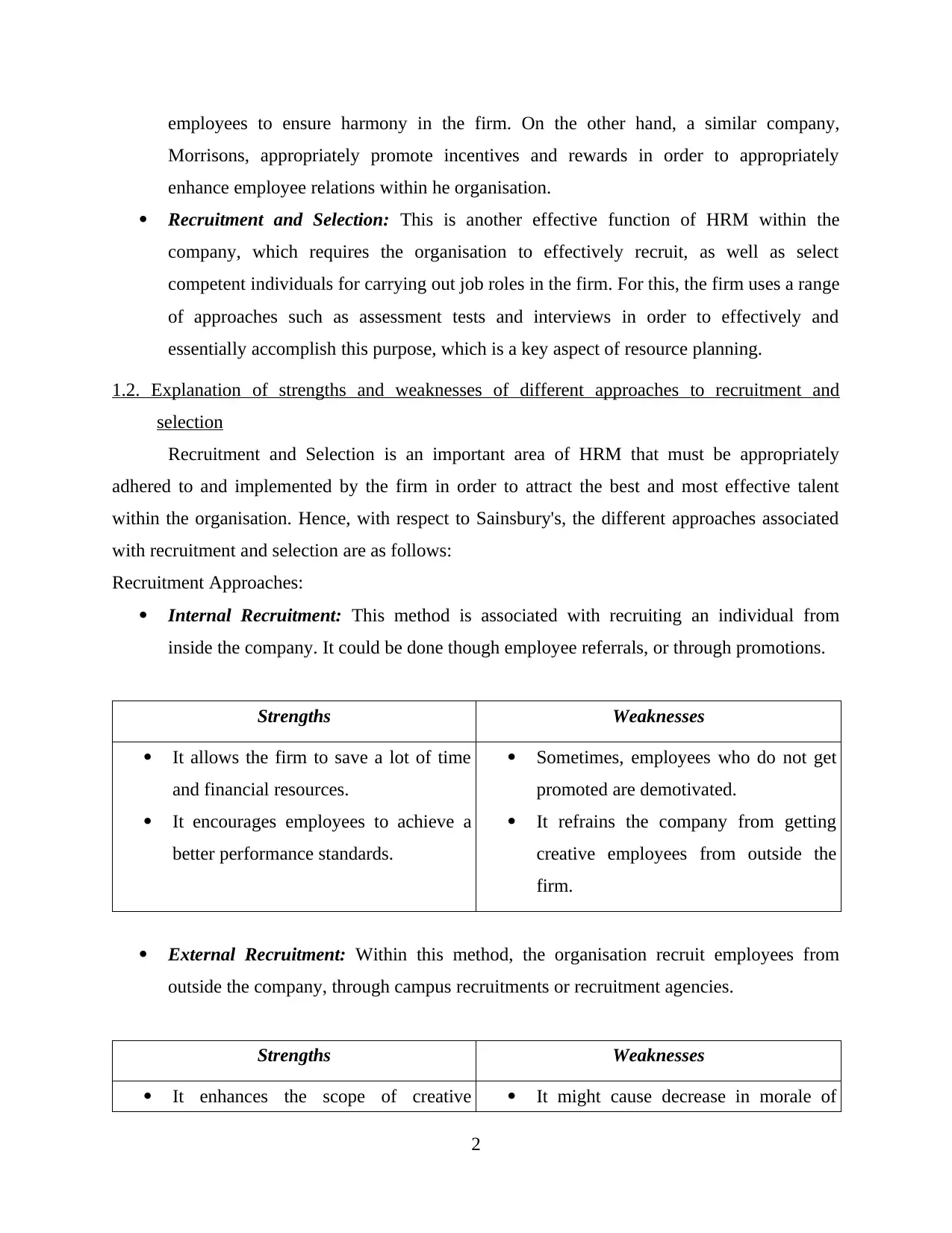
employees to ensure harmony in the firm. On the other hand, a similar company,
Morrisons, appropriately promote incentives and rewards in order to appropriately
enhance employee relations within he organisation.
Recruitment and Selection: This is another effective function of HRM within the
company, which requires the organisation to effectively recruit, as well as select
competent individuals for carrying out job roles in the firm. For this, the firm uses a range
of approaches such as assessment tests and interviews in order to effectively and
essentially accomplish this purpose, which is a key aspect of resource planning.
1.2. Explanation of strengths and weaknesses of different approaches to recruitment and
selection
Recruitment and Selection is an important area of HRM that must be appropriately
adhered to and implemented by the firm in order to attract the best and most effective talent
within the organisation. Hence, with respect to Sainsbury's, the different approaches associated
with recruitment and selection are as follows:
Recruitment Approaches:
Internal Recruitment: This method is associated with recruiting an individual from
inside the company. It could be done though employee referrals, or through promotions.
Strengths Weaknesses
It allows the firm to save a lot of time
and financial resources.
It encourages employees to achieve a
better performance standards.
Sometimes, employees who do not get
promoted are demotivated.
It refrains the company from getting
creative employees from outside the
firm.
External Recruitment: Within this method, the organisation recruit employees from
outside the company, through campus recruitments or recruitment agencies.
Strengths Weaknesses
It enhances the scope of creative It might cause decrease in morale of
2
Morrisons, appropriately promote incentives and rewards in order to appropriately
enhance employee relations within he organisation.
Recruitment and Selection: This is another effective function of HRM within the
company, which requires the organisation to effectively recruit, as well as select
competent individuals for carrying out job roles in the firm. For this, the firm uses a range
of approaches such as assessment tests and interviews in order to effectively and
essentially accomplish this purpose, which is a key aspect of resource planning.
1.2. Explanation of strengths and weaknesses of different approaches to recruitment and
selection
Recruitment and Selection is an important area of HRM that must be appropriately
adhered to and implemented by the firm in order to attract the best and most effective talent
within the organisation. Hence, with respect to Sainsbury's, the different approaches associated
with recruitment and selection are as follows:
Recruitment Approaches:
Internal Recruitment: This method is associated with recruiting an individual from
inside the company. It could be done though employee referrals, or through promotions.
Strengths Weaknesses
It allows the firm to save a lot of time
and financial resources.
It encourages employees to achieve a
better performance standards.
Sometimes, employees who do not get
promoted are demotivated.
It refrains the company from getting
creative employees from outside the
firm.
External Recruitment: Within this method, the organisation recruit employees from
outside the company, through campus recruitments or recruitment agencies.
Strengths Weaknesses
It enhances the scope of creative It might cause decrease in morale of
2
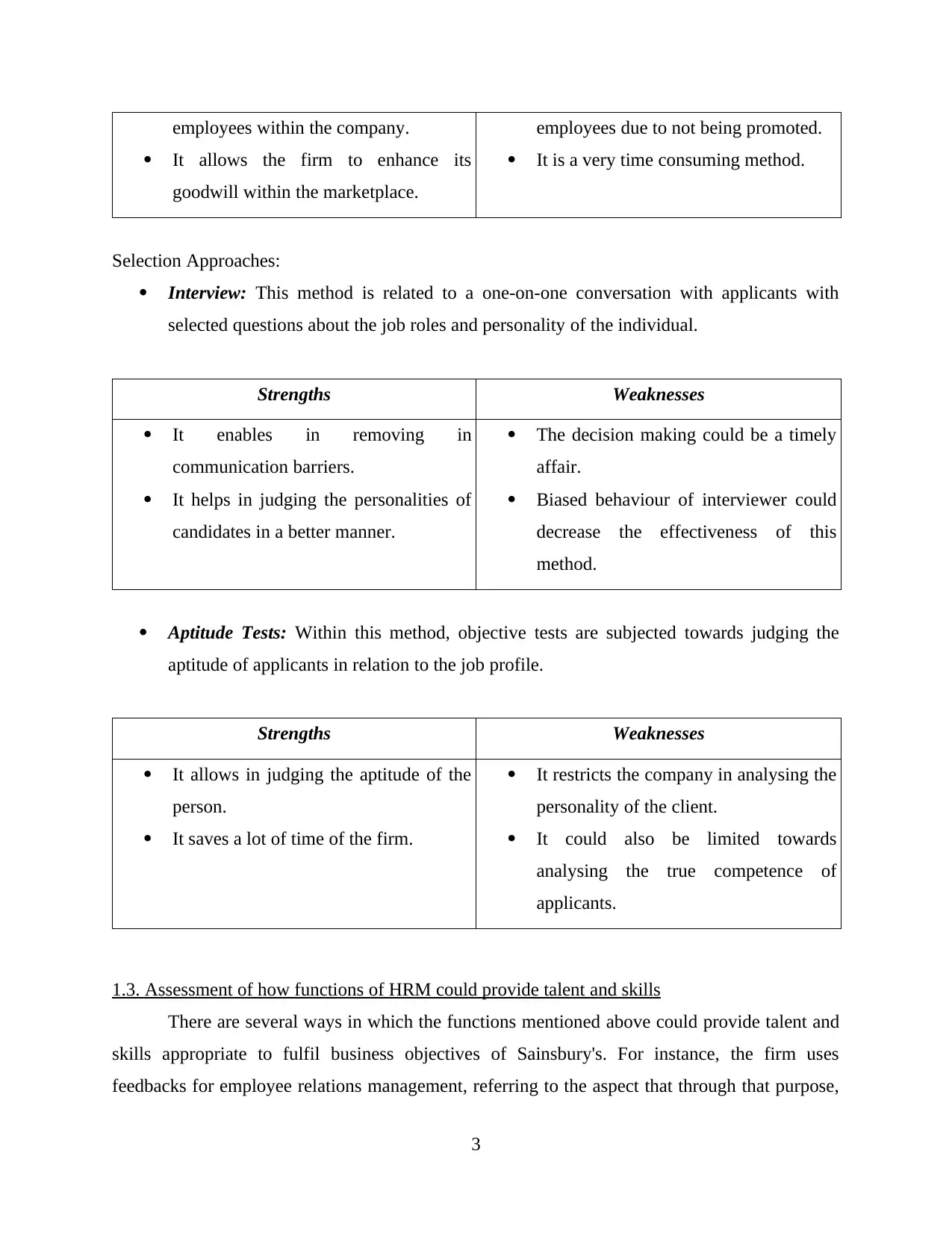
employees within the company.
It allows the firm to enhance its
goodwill within the marketplace.
employees due to not being promoted.
It is a very time consuming method.
Selection Approaches:
Interview: This method is related to a one-on-one conversation with applicants with
selected questions about the job roles and personality of the individual.
Strengths Weaknesses
It enables in removing in
communication barriers.
It helps in judging the personalities of
candidates in a better manner.
The decision making could be a timely
affair.
Biased behaviour of interviewer could
decrease the effectiveness of this
method.
Aptitude Tests: Within this method, objective tests are subjected towards judging the
aptitude of applicants in relation to the job profile.
Strengths Weaknesses
It allows in judging the aptitude of the
person.
It saves a lot of time of the firm.
It restricts the company in analysing the
personality of the client.
It could also be limited towards
analysing the true competence of
applicants.
1.3. Assessment of how functions of HRM could provide talent and skills
There are several ways in which the functions mentioned above could provide talent and
skills appropriate to fulfil business objectives of Sainsbury's. For instance, the firm uses
feedbacks for employee relations management, referring to the aspect that through that purpose,
3
It allows the firm to enhance its
goodwill within the marketplace.
employees due to not being promoted.
It is a very time consuming method.
Selection Approaches:
Interview: This method is related to a one-on-one conversation with applicants with
selected questions about the job roles and personality of the individual.
Strengths Weaknesses
It enables in removing in
communication barriers.
It helps in judging the personalities of
candidates in a better manner.
The decision making could be a timely
affair.
Biased behaviour of interviewer could
decrease the effectiveness of this
method.
Aptitude Tests: Within this method, objective tests are subjected towards judging the
aptitude of applicants in relation to the job profile.
Strengths Weaknesses
It allows in judging the aptitude of the
person.
It saves a lot of time of the firm.
It restricts the company in analysing the
personality of the client.
It could also be limited towards
analysing the true competence of
applicants.
1.3. Assessment of how functions of HRM could provide talent and skills
There are several ways in which the functions mentioned above could provide talent and
skills appropriate to fulfil business objectives of Sainsbury's. For instance, the firm uses
feedbacks for employee relations management, referring to the aspect that through that purpose,
3
⊘ This is a preview!⊘
Do you want full access?
Subscribe today to unlock all pages.

Trusted by 1+ million students worldwide
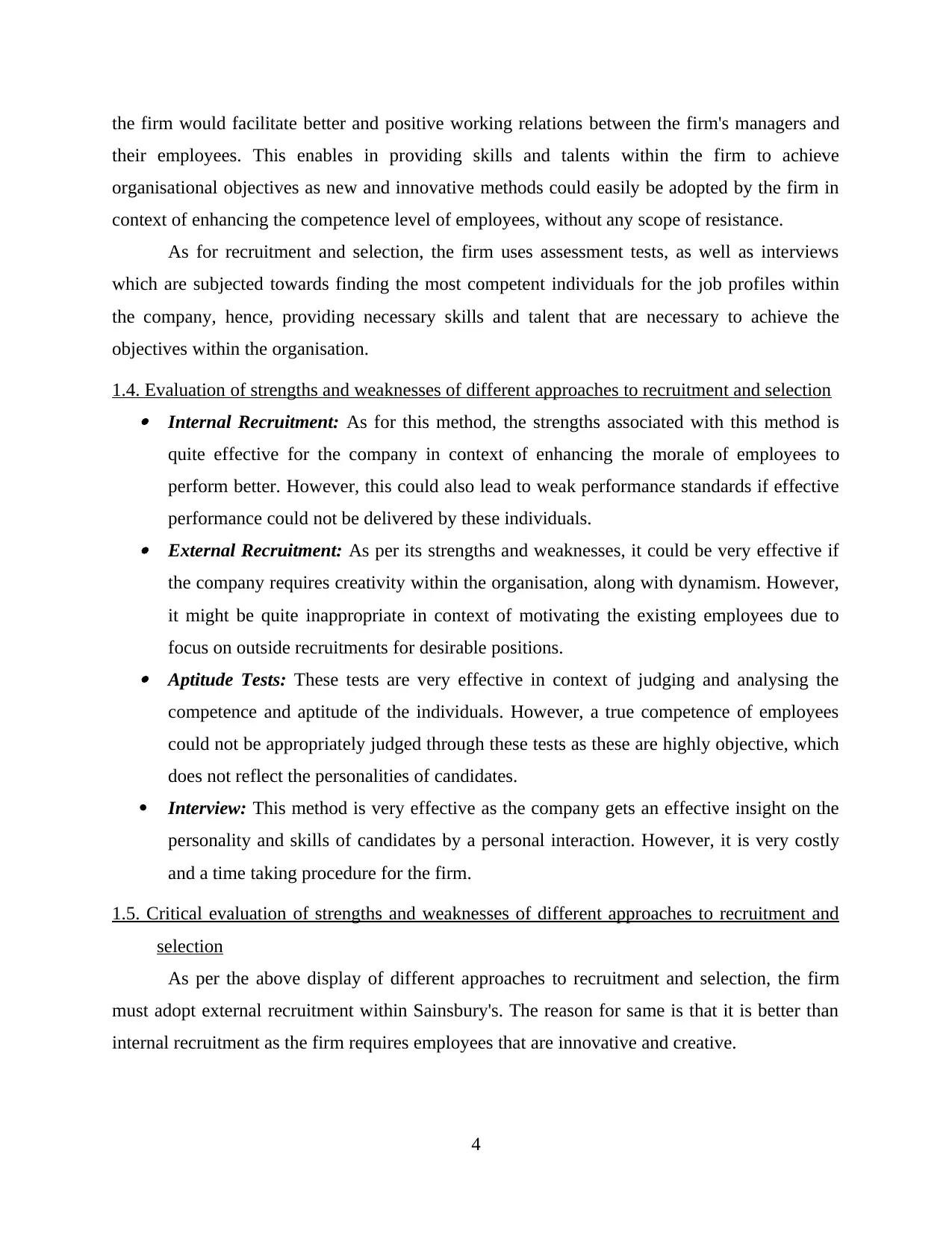
the firm would facilitate better and positive working relations between the firm's managers and
their employees. This enables in providing skills and talents within the firm to achieve
organisational objectives as new and innovative methods could easily be adopted by the firm in
context of enhancing the competence level of employees, without any scope of resistance.
As for recruitment and selection, the firm uses assessment tests, as well as interviews
which are subjected towards finding the most competent individuals for the job profiles within
the company, hence, providing necessary skills and talent that are necessary to achieve the
objectives within the organisation.
1.4. Evaluation of strengths and weaknesses of different approaches to recruitment and selection Internal Recruitment: As for this method, the strengths associated with this method is
quite effective for the company in context of enhancing the morale of employees to
perform better. However, this could also lead to weak performance standards if effective
performance could not be delivered by these individuals. External Recruitment: As per its strengths and weaknesses, it could be very effective if
the company requires creativity within the organisation, along with dynamism. However,
it might be quite inappropriate in context of motivating the existing employees due to
focus on outside recruitments for desirable positions. Aptitude Tests: These tests are very effective in context of judging and analysing the
competence and aptitude of the individuals. However, a true competence of employees
could not be appropriately judged through these tests as these are highly objective, which
does not reflect the personalities of candidates.
Interview: This method is very effective as the company gets an effective insight on the
personality and skills of candidates by a personal interaction. However, it is very costly
and a time taking procedure for the firm.
1.5. Critical evaluation of strengths and weaknesses of different approaches to recruitment and
selection
As per the above display of different approaches to recruitment and selection, the firm
must adopt external recruitment within Sainsbury's. The reason for same is that it is better than
internal recruitment as the firm requires employees that are innovative and creative.
4
their employees. This enables in providing skills and talents within the firm to achieve
organisational objectives as new and innovative methods could easily be adopted by the firm in
context of enhancing the competence level of employees, without any scope of resistance.
As for recruitment and selection, the firm uses assessment tests, as well as interviews
which are subjected towards finding the most competent individuals for the job profiles within
the company, hence, providing necessary skills and talent that are necessary to achieve the
objectives within the organisation.
1.4. Evaluation of strengths and weaknesses of different approaches to recruitment and selection Internal Recruitment: As for this method, the strengths associated with this method is
quite effective for the company in context of enhancing the morale of employees to
perform better. However, this could also lead to weak performance standards if effective
performance could not be delivered by these individuals. External Recruitment: As per its strengths and weaknesses, it could be very effective if
the company requires creativity within the organisation, along with dynamism. However,
it might be quite inappropriate in context of motivating the existing employees due to
focus on outside recruitments for desirable positions. Aptitude Tests: These tests are very effective in context of judging and analysing the
competence and aptitude of the individuals. However, a true competence of employees
could not be appropriately judged through these tests as these are highly objective, which
does not reflect the personalities of candidates.
Interview: This method is very effective as the company gets an effective insight on the
personality and skills of candidates by a personal interaction. However, it is very costly
and a time taking procedure for the firm.
1.5. Critical evaluation of strengths and weaknesses of different approaches to recruitment and
selection
As per the above display of different approaches to recruitment and selection, the firm
must adopt external recruitment within Sainsbury's. The reason for same is that it is better than
internal recruitment as the firm requires employees that are innovative and creative.
4
Paraphrase This Document
Need a fresh take? Get an instant paraphrase of this document with our AI Paraphraser
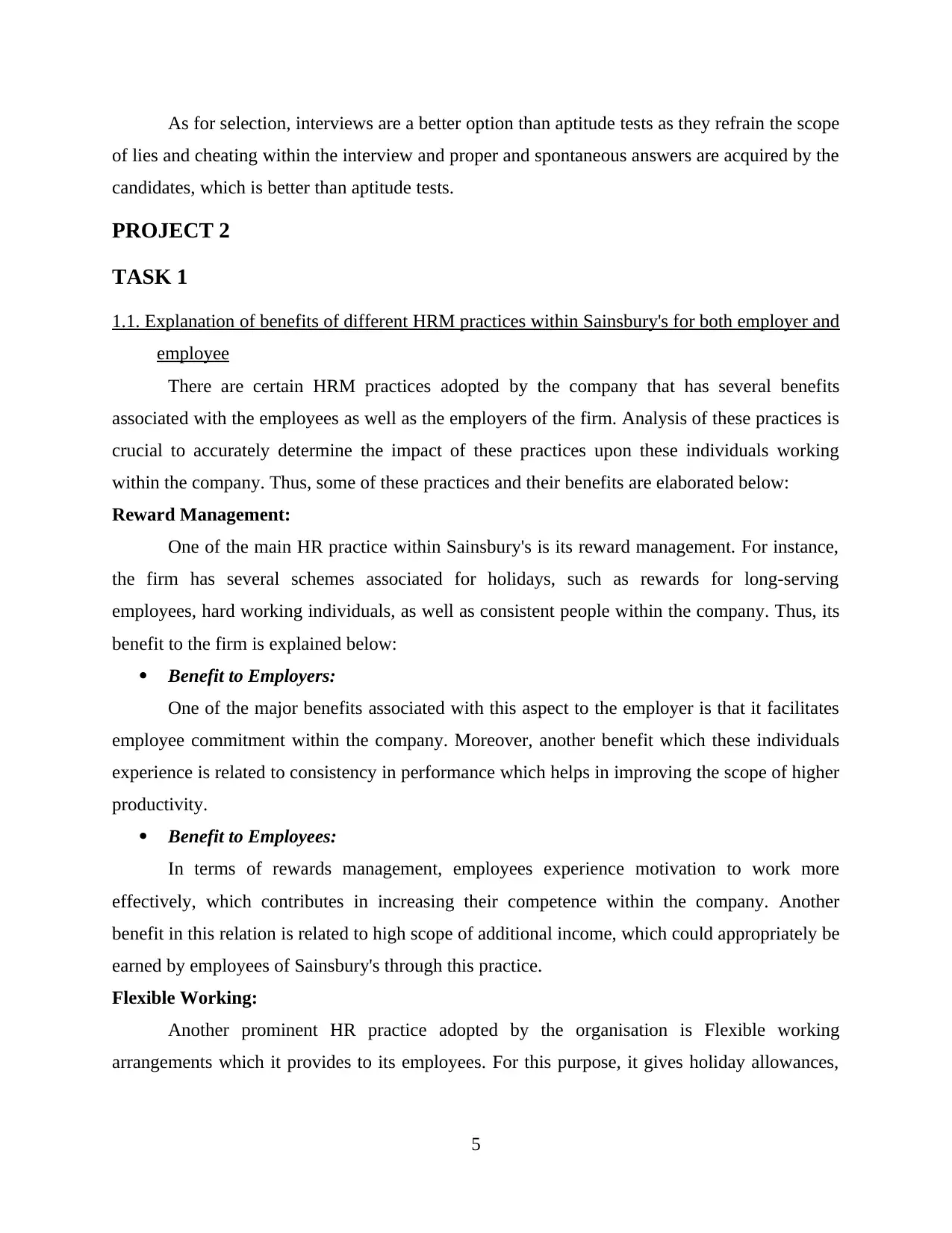
As for selection, interviews are a better option than aptitude tests as they refrain the scope
of lies and cheating within the interview and proper and spontaneous answers are acquired by the
candidates, which is better than aptitude tests.
PROJECT 2
TASK 1
1.1. Explanation of benefits of different HRM practices within Sainsbury's for both employer and
employee
There are certain HRM practices adopted by the company that has several benefits
associated with the employees as well as the employers of the firm. Analysis of these practices is
crucial to accurately determine the impact of these practices upon these individuals working
within the company. Thus, some of these practices and their benefits are elaborated below:
Reward Management:
One of the main HR practice within Sainsbury's is its reward management. For instance,
the firm has several schemes associated for holidays, such as rewards for long-serving
employees, hard working individuals, as well as consistent people within the company. Thus, its
benefit to the firm is explained below:
Benefit to Employers:
One of the major benefits associated with this aspect to the employer is that it facilitates
employee commitment within the company. Moreover, another benefit which these individuals
experience is related to consistency in performance which helps in improving the scope of higher
productivity.
Benefit to Employees:
In terms of rewards management, employees experience motivation to work more
effectively, which contributes in increasing their competence within the company. Another
benefit in this relation is related to high scope of additional income, which could appropriately be
earned by employees of Sainsbury's through this practice.
Flexible Working:
Another prominent HR practice adopted by the organisation is Flexible working
arrangements which it provides to its employees. For this purpose, it gives holiday allowances,
5
of lies and cheating within the interview and proper and spontaneous answers are acquired by the
candidates, which is better than aptitude tests.
PROJECT 2
TASK 1
1.1. Explanation of benefits of different HRM practices within Sainsbury's for both employer and
employee
There are certain HRM practices adopted by the company that has several benefits
associated with the employees as well as the employers of the firm. Analysis of these practices is
crucial to accurately determine the impact of these practices upon these individuals working
within the company. Thus, some of these practices and their benefits are elaborated below:
Reward Management:
One of the main HR practice within Sainsbury's is its reward management. For instance,
the firm has several schemes associated for holidays, such as rewards for long-serving
employees, hard working individuals, as well as consistent people within the company. Thus, its
benefit to the firm is explained below:
Benefit to Employers:
One of the major benefits associated with this aspect to the employer is that it facilitates
employee commitment within the company. Moreover, another benefit which these individuals
experience is related to consistency in performance which helps in improving the scope of higher
productivity.
Benefit to Employees:
In terms of rewards management, employees experience motivation to work more
effectively, which contributes in increasing their competence within the company. Another
benefit in this relation is related to high scope of additional income, which could appropriately be
earned by employees of Sainsbury's through this practice.
Flexible Working:
Another prominent HR practice adopted by the organisation is Flexible working
arrangements which it provides to its employees. For this purpose, it gives holiday allowances,
5
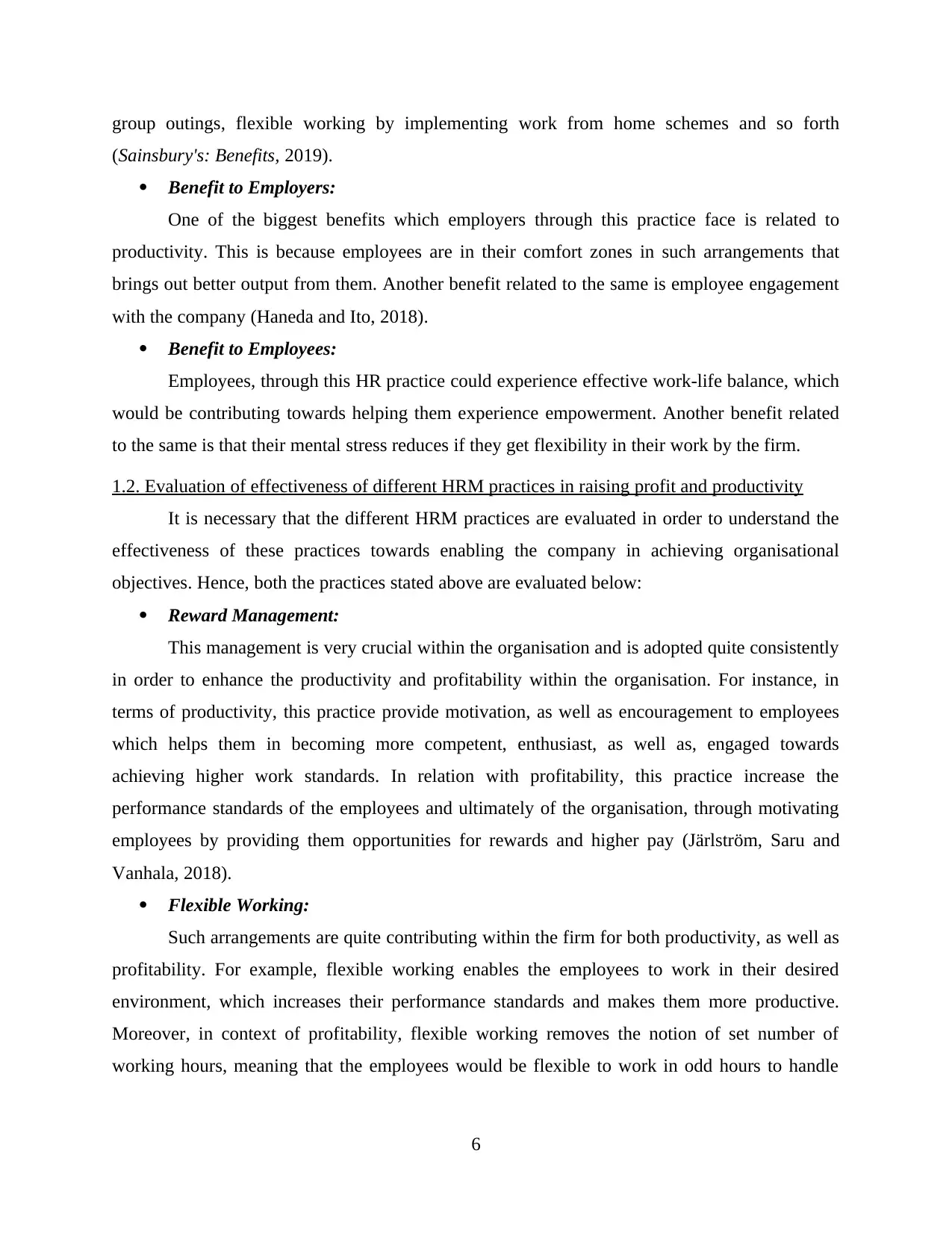
group outings, flexible working by implementing work from home schemes and so forth
(Sainsbury's: Benefits, 2019).
Benefit to Employers:
One of the biggest benefits which employers through this practice face is related to
productivity. This is because employees are in their comfort zones in such arrangements that
brings out better output from them. Another benefit related to the same is employee engagement
with the company (Haneda and Ito, 2018).
Benefit to Employees:
Employees, through this HR practice could experience effective work-life balance, which
would be contributing towards helping them experience empowerment. Another benefit related
to the same is that their mental stress reduces if they get flexibility in their work by the firm.
1.2. Evaluation of effectiveness of different HRM practices in raising profit and productivity
It is necessary that the different HRM practices are evaluated in order to understand the
effectiveness of these practices towards enabling the company in achieving organisational
objectives. Hence, both the practices stated above are evaluated below:
Reward Management:
This management is very crucial within the organisation and is adopted quite consistently
in order to enhance the productivity and profitability within the organisation. For instance, in
terms of productivity, this practice provide motivation, as well as encouragement to employees
which helps them in becoming more competent, enthusiast, as well as, engaged towards
achieving higher work standards. In relation with profitability, this practice increase the
performance standards of the employees and ultimately of the organisation, through motivating
employees by providing them opportunities for rewards and higher pay (Järlström, Saru and
Vanhala, 2018).
Flexible Working:
Such arrangements are quite contributing within the firm for both productivity, as well as
profitability. For example, flexible working enables the employees to work in their desired
environment, which increases their performance standards and makes them more productive.
Moreover, in context of profitability, flexible working removes the notion of set number of
working hours, meaning that the employees would be flexible to work in odd hours to handle
6
(Sainsbury's: Benefits, 2019).
Benefit to Employers:
One of the biggest benefits which employers through this practice face is related to
productivity. This is because employees are in their comfort zones in such arrangements that
brings out better output from them. Another benefit related to the same is employee engagement
with the company (Haneda and Ito, 2018).
Benefit to Employees:
Employees, through this HR practice could experience effective work-life balance, which
would be contributing towards helping them experience empowerment. Another benefit related
to the same is that their mental stress reduces if they get flexibility in their work by the firm.
1.2. Evaluation of effectiveness of different HRM practices in raising profit and productivity
It is necessary that the different HRM practices are evaluated in order to understand the
effectiveness of these practices towards enabling the company in achieving organisational
objectives. Hence, both the practices stated above are evaluated below:
Reward Management:
This management is very crucial within the organisation and is adopted quite consistently
in order to enhance the productivity and profitability within the organisation. For instance, in
terms of productivity, this practice provide motivation, as well as encouragement to employees
which helps them in becoming more competent, enthusiast, as well as, engaged towards
achieving higher work standards. In relation with profitability, this practice increase the
performance standards of the employees and ultimately of the organisation, through motivating
employees by providing them opportunities for rewards and higher pay (Järlström, Saru and
Vanhala, 2018).
Flexible Working:
Such arrangements are quite contributing within the firm for both productivity, as well as
profitability. For example, flexible working enables the employees to work in their desired
environment, which increases their performance standards and makes them more productive.
Moreover, in context of profitability, flexible working removes the notion of set number of
working hours, meaning that the employees would be flexible to work in odd hours to handle
6
⊘ This is a preview!⊘
Do you want full access?
Subscribe today to unlock all pages.

Trusted by 1+ million students worldwide
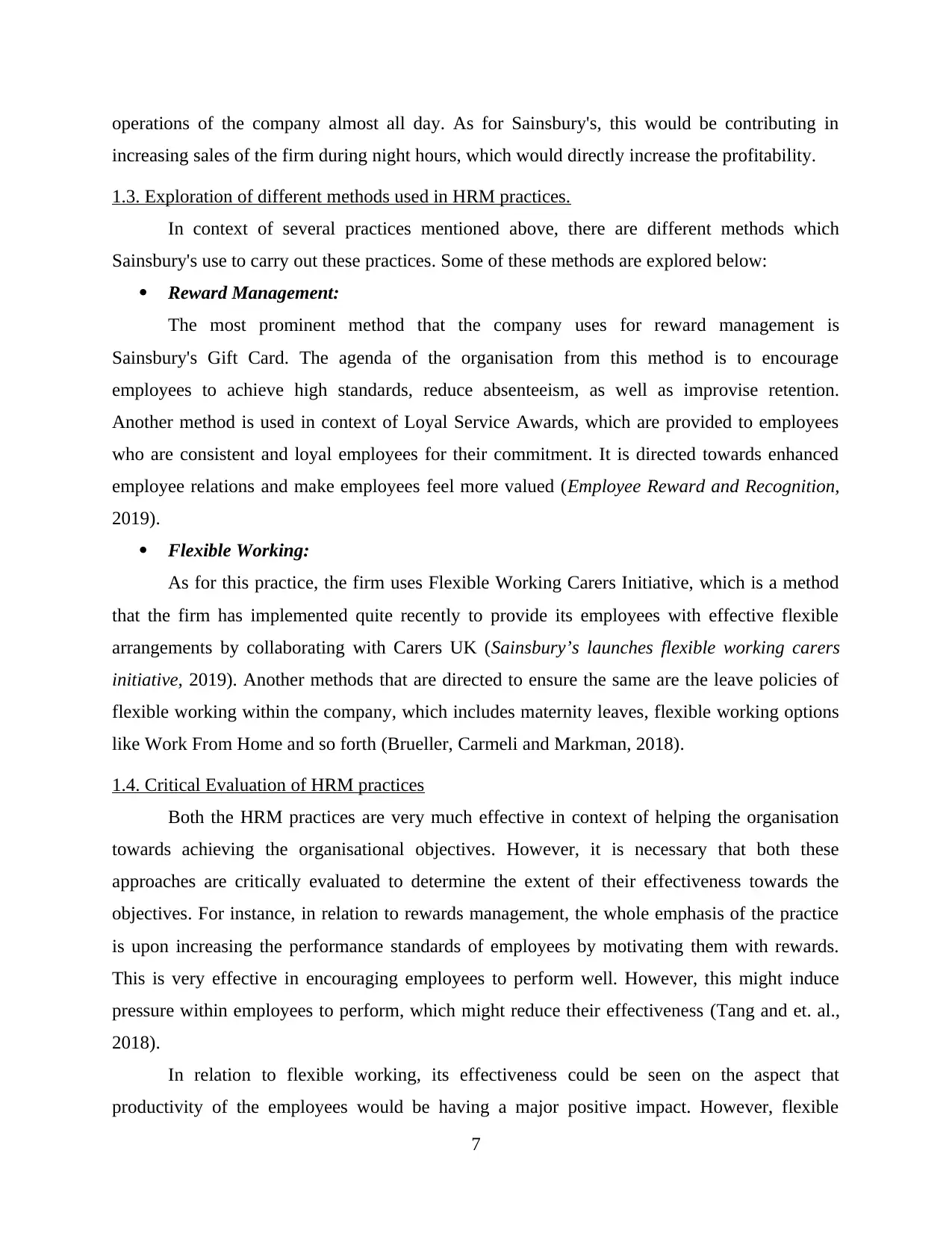
operations of the company almost all day. As for Sainsbury's, this would be contributing in
increasing sales of the firm during night hours, which would directly increase the profitability.
1.3. Exploration of different methods used in HRM practices.
In context of several practices mentioned above, there are different methods which
Sainsbury's use to carry out these practices. Some of these methods are explored below:
Reward Management:
The most prominent method that the company uses for reward management is
Sainsbury's Gift Card. The agenda of the organisation from this method is to encourage
employees to achieve high standards, reduce absenteeism, as well as improvise retention.
Another method is used in context of Loyal Service Awards, which are provided to employees
who are consistent and loyal employees for their commitment. It is directed towards enhanced
employee relations and make employees feel more valued (Employee Reward and Recognition,
2019).
Flexible Working:
As for this practice, the firm uses Flexible Working Carers Initiative, which is a method
that the firm has implemented quite recently to provide its employees with effective flexible
arrangements by collaborating with Carers UK (Sainsbury’s launches flexible working carers
initiative, 2019). Another methods that are directed to ensure the same are the leave policies of
flexible working within the company, which includes maternity leaves, flexible working options
like Work From Home and so forth (Brueller, Carmeli and Markman, 2018).
1.4. Critical Evaluation of HRM practices
Both the HRM practices are very much effective in context of helping the organisation
towards achieving the organisational objectives. However, it is necessary that both these
approaches are critically evaluated to determine the extent of their effectiveness towards the
objectives. For instance, in relation to rewards management, the whole emphasis of the practice
is upon increasing the performance standards of employees by motivating them with rewards.
This is very effective in encouraging employees to perform well. However, this might induce
pressure within employees to perform, which might reduce their effectiveness (Tang and et. al.,
2018).
In relation to flexible working, its effectiveness could be seen on the aspect that
productivity of the employees would be having a major positive impact. However, flexible
7
increasing sales of the firm during night hours, which would directly increase the profitability.
1.3. Exploration of different methods used in HRM practices.
In context of several practices mentioned above, there are different methods which
Sainsbury's use to carry out these practices. Some of these methods are explored below:
Reward Management:
The most prominent method that the company uses for reward management is
Sainsbury's Gift Card. The agenda of the organisation from this method is to encourage
employees to achieve high standards, reduce absenteeism, as well as improvise retention.
Another method is used in context of Loyal Service Awards, which are provided to employees
who are consistent and loyal employees for their commitment. It is directed towards enhanced
employee relations and make employees feel more valued (Employee Reward and Recognition,
2019).
Flexible Working:
As for this practice, the firm uses Flexible Working Carers Initiative, which is a method
that the firm has implemented quite recently to provide its employees with effective flexible
arrangements by collaborating with Carers UK (Sainsbury’s launches flexible working carers
initiative, 2019). Another methods that are directed to ensure the same are the leave policies of
flexible working within the company, which includes maternity leaves, flexible working options
like Work From Home and so forth (Brueller, Carmeli and Markman, 2018).
1.4. Critical Evaluation of HRM practices
Both the HRM practices are very much effective in context of helping the organisation
towards achieving the organisational objectives. However, it is necessary that both these
approaches are critically evaluated to determine the extent of their effectiveness towards the
objectives. For instance, in relation to rewards management, the whole emphasis of the practice
is upon increasing the performance standards of employees by motivating them with rewards.
This is very effective in encouraging employees to perform well. However, this might induce
pressure within employees to perform, which might reduce their effectiveness (Tang and et. al.,
2018).
In relation to flexible working, its effectiveness could be seen on the aspect that
productivity of the employees would be having a major positive impact. However, flexible
7
Paraphrase This Document
Need a fresh take? Get an instant paraphrase of this document with our AI Paraphraser
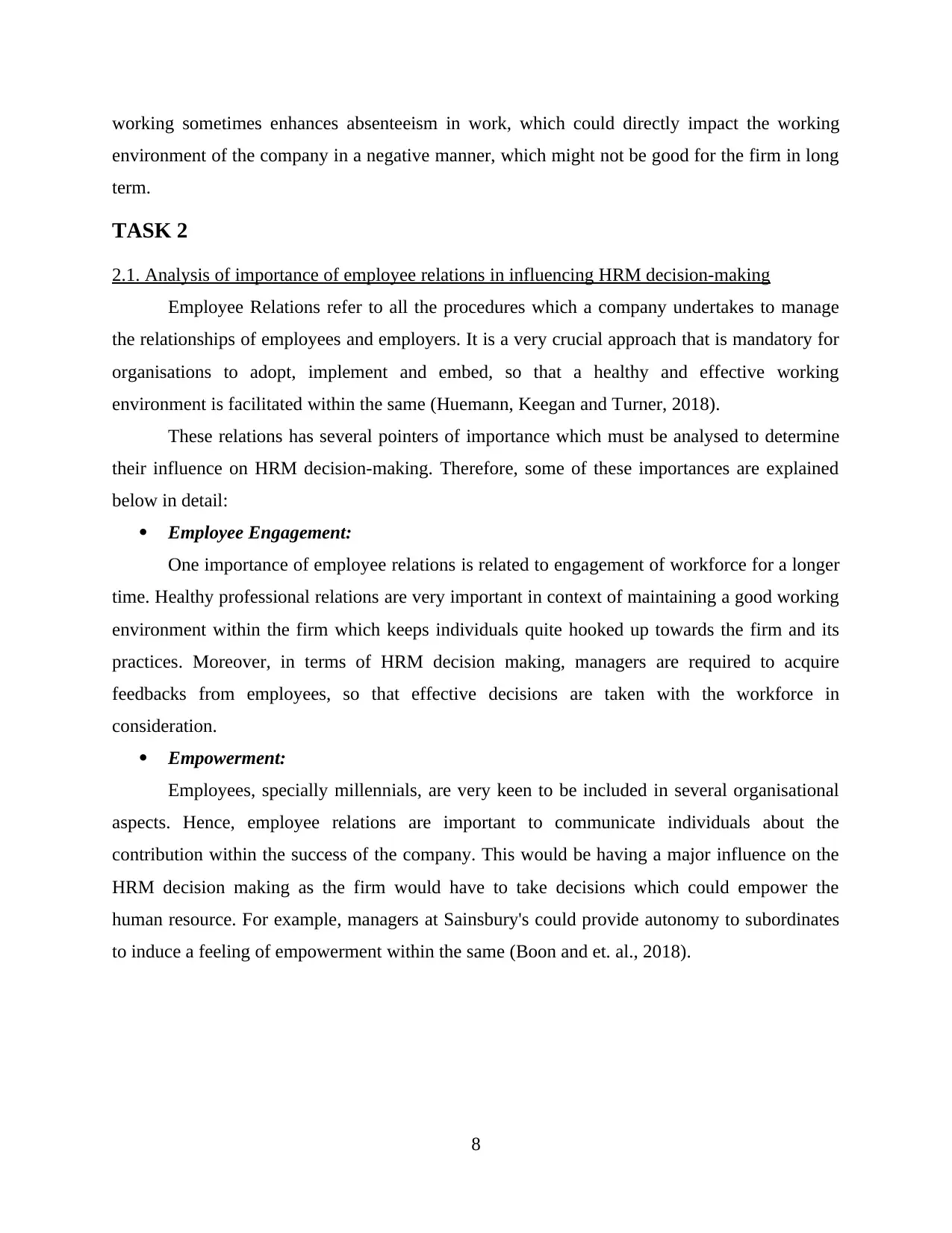
working sometimes enhances absenteeism in work, which could directly impact the working
environment of the company in a negative manner, which might not be good for the firm in long
term.
TASK 2
2.1. Analysis of importance of employee relations in influencing HRM decision-making
Employee Relations refer to all the procedures which a company undertakes to manage
the relationships of employees and employers. It is a very crucial approach that is mandatory for
organisations to adopt, implement and embed, so that a healthy and effective working
environment is facilitated within the same (Huemann, Keegan and Turner, 2018).
These relations has several pointers of importance which must be analysed to determine
their influence on HRM decision-making. Therefore, some of these importances are explained
below in detail:
Employee Engagement:
One importance of employee relations is related to engagement of workforce for a longer
time. Healthy professional relations are very important in context of maintaining a good working
environment within the firm which keeps individuals quite hooked up towards the firm and its
practices. Moreover, in terms of HRM decision making, managers are required to acquire
feedbacks from employees, so that effective decisions are taken with the workforce in
consideration.
Empowerment:
Employees, specially millennials, are very keen to be included in several organisational
aspects. Hence, employee relations are important to communicate individuals about the
contribution within the success of the company. This would be having a major influence on the
HRM decision making as the firm would have to take decisions which could empower the
human resource. For example, managers at Sainsbury's could provide autonomy to subordinates
to induce a feeling of empowerment within the same (Boon and et. al., 2018).
8
environment of the company in a negative manner, which might not be good for the firm in long
term.
TASK 2
2.1. Analysis of importance of employee relations in influencing HRM decision-making
Employee Relations refer to all the procedures which a company undertakes to manage
the relationships of employees and employers. It is a very crucial approach that is mandatory for
organisations to adopt, implement and embed, so that a healthy and effective working
environment is facilitated within the same (Huemann, Keegan and Turner, 2018).
These relations has several pointers of importance which must be analysed to determine
their influence on HRM decision-making. Therefore, some of these importances are explained
below in detail:
Employee Engagement:
One importance of employee relations is related to engagement of workforce for a longer
time. Healthy professional relations are very important in context of maintaining a good working
environment within the firm which keeps individuals quite hooked up towards the firm and its
practices. Moreover, in terms of HRM decision making, managers are required to acquire
feedbacks from employees, so that effective decisions are taken with the workforce in
consideration.
Empowerment:
Employees, specially millennials, are very keen to be included in several organisational
aspects. Hence, employee relations are important to communicate individuals about the
contribution within the success of the company. This would be having a major influence on the
HRM decision making as the firm would have to take decisions which could empower the
human resource. For example, managers at Sainsbury's could provide autonomy to subordinates
to induce a feeling of empowerment within the same (Boon and et. al., 2018).
8
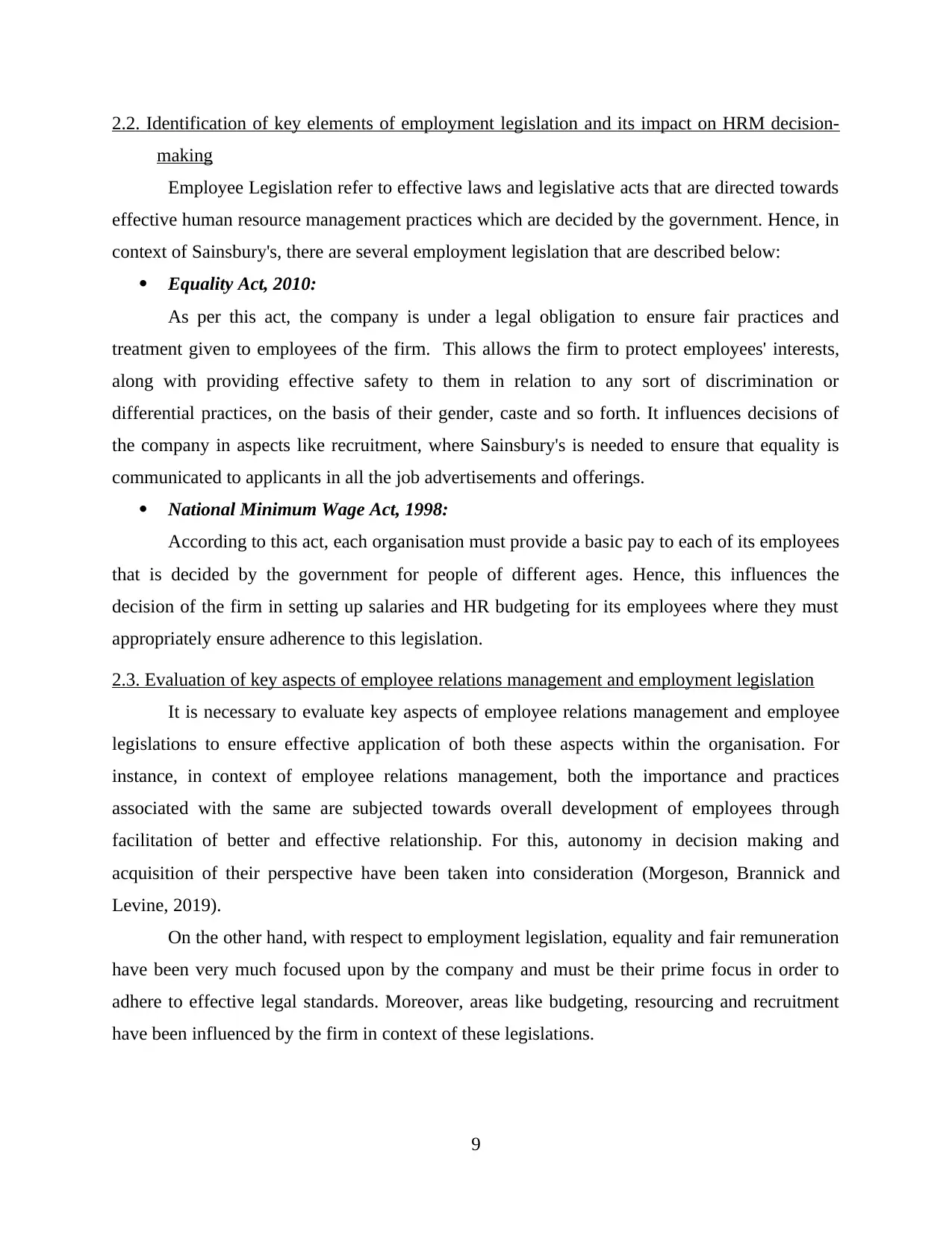
2.2. Identification of key elements of employment legislation and its impact on HRM decision-
making
Employee Legislation refer to effective laws and legislative acts that are directed towards
effective human resource management practices which are decided by the government. Hence, in
context of Sainsbury's, there are several employment legislation that are described below:
Equality Act, 2010:
As per this act, the company is under a legal obligation to ensure fair practices and
treatment given to employees of the firm. This allows the firm to protect employees' interests,
along with providing effective safety to them in relation to any sort of discrimination or
differential practices, on the basis of their gender, caste and so forth. It influences decisions of
the company in aspects like recruitment, where Sainsbury's is needed to ensure that equality is
communicated to applicants in all the job advertisements and offerings.
National Minimum Wage Act, 1998:
According to this act, each organisation must provide a basic pay to each of its employees
that is decided by the government for people of different ages. Hence, this influences the
decision of the firm in setting up salaries and HR budgeting for its employees where they must
appropriately ensure adherence to this legislation.
2.3. Evaluation of key aspects of employee relations management and employment legislation
It is necessary to evaluate key aspects of employee relations management and employee
legislations to ensure effective application of both these aspects within the organisation. For
instance, in context of employee relations management, both the importance and practices
associated with the same are subjected towards overall development of employees through
facilitation of better and effective relationship. For this, autonomy in decision making and
acquisition of their perspective have been taken into consideration (Morgeson, Brannick and
Levine, 2019).
On the other hand, with respect to employment legislation, equality and fair remuneration
have been very much focused upon by the company and must be their prime focus in order to
adhere to effective legal standards. Moreover, areas like budgeting, resourcing and recruitment
have been influenced by the firm in context of these legislations.
9
making
Employee Legislation refer to effective laws and legislative acts that are directed towards
effective human resource management practices which are decided by the government. Hence, in
context of Sainsbury's, there are several employment legislation that are described below:
Equality Act, 2010:
As per this act, the company is under a legal obligation to ensure fair practices and
treatment given to employees of the firm. This allows the firm to protect employees' interests,
along with providing effective safety to them in relation to any sort of discrimination or
differential practices, on the basis of their gender, caste and so forth. It influences decisions of
the company in aspects like recruitment, where Sainsbury's is needed to ensure that equality is
communicated to applicants in all the job advertisements and offerings.
National Minimum Wage Act, 1998:
According to this act, each organisation must provide a basic pay to each of its employees
that is decided by the government for people of different ages. Hence, this influences the
decision of the firm in setting up salaries and HR budgeting for its employees where they must
appropriately ensure adherence to this legislation.
2.3. Evaluation of key aspects of employee relations management and employment legislation
It is necessary to evaluate key aspects of employee relations management and employee
legislations to ensure effective application of both these aspects within the organisation. For
instance, in context of employee relations management, both the importance and practices
associated with the same are subjected towards overall development of employees through
facilitation of better and effective relationship. For this, autonomy in decision making and
acquisition of their perspective have been taken into consideration (Morgeson, Brannick and
Levine, 2019).
On the other hand, with respect to employment legislation, equality and fair remuneration
have been very much focused upon by the company and must be their prime focus in order to
adhere to effective legal standards. Moreover, areas like budgeting, resourcing and recruitment
have been influenced by the firm in context of these legislations.
9
⊘ This is a preview!⊘
Do you want full access?
Subscribe today to unlock all pages.

Trusted by 1+ million students worldwide
1 out of 16
Related Documents
Your All-in-One AI-Powered Toolkit for Academic Success.
+13062052269
info@desklib.com
Available 24*7 on WhatsApp / Email
![[object Object]](/_next/static/media/star-bottom.7253800d.svg)
Unlock your academic potential
Copyright © 2020–2025 A2Z Services. All Rights Reserved. Developed and managed by ZUCOL.




